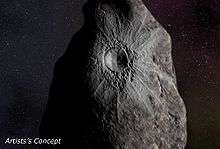Minor planet designation

Formal minor planet designations are number–name combinations overseen by the Minor Planet Center, a branch of the IAU. They are used for dwarf planets and small Solar System bodies such as asteroids, but not comets. They are assigned to a body once its orbit is secured, and are unrelated to provisional designations, which are automatically assigned when an object is discovered.
The two parts of a formal designation are
- a number, historically assigned in approximate order of discovery, now assigned only after the orbit has been secured by 4 well-observed oppositions,[1] coupled with
- a name, either the name assigned by the discoverer, or, nowadays more commonly, the provisional designation.[2]
The syntax is (number) Name, for example (90377) Sedna or (55636) 2002 TX300. The parentheses are now often dropped, as in 90377 Sedna, according to the preference of the astronomer or journal. In practice, however, for any reasonably well-known object the number is mostly a catalogue entry, and the name or provisional designation is generally used in place of the formal designation: Sedna, 2002 TX300.
For unusual objects, such as near-Earth asteroids (NEAs), numbering might occur after three, maybe even only two, oppositions.[1]
The convention for satellites of minor planets, such as the formal designation (87) Sylvia I Romulus for the asteroid moon Romulus, is an extension of the Roman numeral convention that had been used, on and off, for the moons of the planets since Galileo's time.
Comets are also managed by the Minor Planet Center, but use a different cataloguing system.
History
By 1851 there were 15 known asteroids, all but one with their own symbol. The symbols grew increasingly complex as the number of objects grew, and, as they had to be drawn by hand, astronomers found some of them difficult. This difficulty was addressed by Benjamin Apthorp Gould in 1851, who suggested numbering asteroids in their order of discovery, and placing this number in a circle as the symbol for the asteroid, such as ④ for the fourth asteroid, Vesta. This practice was soon coupled with the name itself into an official number-name designation, "④ Vesta", as the number of minor planets increased. By the late 1850s, the circle had been simplified to parentheses, "(4)" and "(4) Vesta", which was easier to typeset. Other punctuation such as "4) Vesta" and "4, Vesta" was also used, but had more or less completely died out by 1949.[3]
The major exception to the convention that the number tracks the order of discovery or determination of orbit is the case of Pluto. Since Pluto was initially classified as a planet, it was not given a number until a 2006 redefinition of "planet" that excluded it. At that point, Pluto was given the formal designation (134340) Pluto.
As of December 2015, there are more than 450,000 numbered minor planets.[4]
See also
- List of minor planets
- Astronomical naming conventions
- Meanings of asteroid names
- Name conflicts with minor planets
References
- 1 2 "How Are Minor Planets Named?". Minor Planet Center. Retrieved 2014-02-25.
- ↑ IAU FAQ page
- ↑ From Dr. James Hilton's When Did the Asteroids Become Minor Planets?, particularly the discussion of Gould, B. A. 1852, On the Symbolic Notation of the Asteroids, Astronomical Journal, Vol. 2, and immediately subsequent history. The discussion of C. J. Cunningham (1988), also from there, explains the parenthetical part.
- ↑ How Many Solar System Bodies
External links
- IAU FAQ on minor planets
- MPC explanation of provisional designations
- Dr. James Hilton, When Did the Asteroids Become Minor Planets?